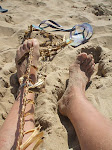A friend once accused me of being addicted to basket making because I take my work with me when I go to the beach. I don't think he intended it as an accusation, but at the time it felt like one. It is true that I get looked at when I work on the beach, but I think most people are just curious to know what I am doing. For me, it is just the pleasure of being able to do work I enjoy in a beautiful outdoor environment.
Rafael Nadal has been the subject of OCD rumours with his twitches, ticks and knicker adjusting on the tennis court, but surely he has to be obsessive about and addicted to tennis in order to be one of the best in the world. A few ticks on the court are just one more manifestation of that. Its' not just sportspeople, but also musicians, artists, authors, actors and scientists, to name just a few, who devote hours and hours to their chosen activity, often to the exclusion of other aspects of their lives.
Obsession in art manifests itself in many ways. With some artists it is the need to explore the same idea or concept over and over again, in order to express that idea or concept in the most effective way. With others it is about seeking technical perfection. Perhaps it was a combination of both of these that led Gabriel Albert to work obsessively for 20 years (1969-89) making the 420 life size cement sculptures that filled his garden. It is said that once he had finished a sculpture he put it outside and wherever he put it that is where it stayed. Apparently he wasn't that interested in positioning them to their best advantage. To me that suggests that he was never really satisfied with his creations and that he felt compelled to go straight back to the workshop and start again, eager to make this next one better than the last. Since Gabriel's death in 2000 at the age of 95, thirty of his sculptures have been stolen and the rest have been gently rotting in his garden. In 2010 the Department decided to document everything and fenced it off. You can visit this monumentally overcrowded garden on one day a year when it is open to the public, but they are perfectly visible through the wire fence if you happen to drive by - it's on the D129 in Charente Maritime.
My 'addiction' if that is what it is, takes a slightly different form to that of Gabriel's but, like his, it's not one
that causes harm to anyone else and if, one day, I finally get it right it will, at least for me, have been worth the effort!






No comments:
Post a Comment